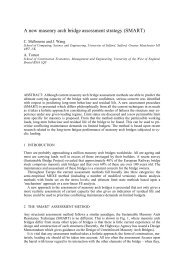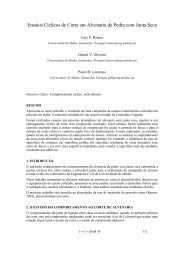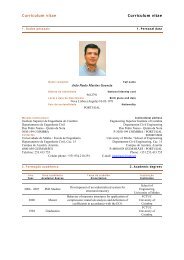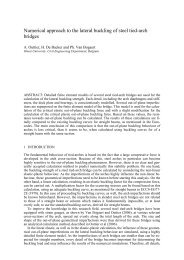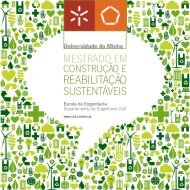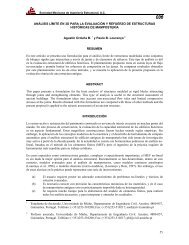Sustainable Construction A Life Cycle Approach in Engineering
Sustainable Construction A Life Cycle Approach in Engineering
Sustainable Construction A Life Cycle Approach in Engineering
Create successful ePaper yourself
Turn your PDF publications into a flip-book with our unique Google optimized e-Paper software.
Consider<strong>in</strong>g these requirements a quadratic structural hollow section accord<strong>in</strong>g to EN 10210<br />
is used. For the steel grade S355 and dimensions 100x100x4 mm, design resistance of 417 kN is<br />
obta<strong>in</strong>ed accord<strong>in</strong>g to EN 1993-1-1. All results below are based on the weight of the chosen<br />
structural hollow section 11.90 kg/m. The total weight of the column is 29.75 kg.<br />
4.2 Steel mak<strong>in</strong>g process<br />
Steel is basically produced <strong>in</strong> two process routes. Primary steel production is mostly done <strong>in</strong> the<br />
blast furnace (BF) route, whereas secondary steel production is made <strong>in</strong> the electric arc furnace<br />
(EAF) route.<br />
The BF route is characterized by reduc<strong>in</strong>g first iron ores to iron and afterwards convert<strong>in</strong>g the<br />
iron to steel. In this process route up to 25 % scrap can be added. The steel mak<strong>in</strong>g process is<br />
realized us<strong>in</strong>g the basic oxygen furnace.<br />
The steelmak<strong>in</strong>g process <strong>in</strong> the EAF route may use as much as almost 100% scrap. The recycled<br />
steel is melted <strong>in</strong> the electric arc furnace.<br />
Steel produced from both routes can be f<strong>in</strong>alized <strong>in</strong>to hot or cold roll<strong>in</strong>g products.<br />
4.3 Environmental declaration<br />
Environmental declarations (EPD) of steel product for Norwegian steel association and Contiga<br />
AS are used to asses environmental impact of the steel column. Documents were issued by<br />
SINTEF Build<strong>in</strong>g and Infrastructure (SINTEF 2007a) accord<strong>in</strong>g to ISO 14044, ISO 14025, ISO<br />
21930 and product category rules of steel as construction materials. The results were obta<strong>in</strong>ed<br />
by us<strong>in</strong>g the EcoDec-tool, which is a non commercial tool, developed at SINTEF Build<strong>in</strong>g and<br />
Infrastructure, for “cradle to gate” and “cradle to grave” declarations (see Figure 4).<br />
Details for the cradle to grave EPD are carried out by us<strong>in</strong>g data from European mills and<br />
Contiga AS, a manufacturer of prefabricated solutions of build<strong>in</strong>g frame structures of steel and<br />
concrete. The declared unit is per kg steel.<br />
Raw materials<br />
Manufactur<strong>in</strong>g<br />
Cradle to gate<br />
Build<strong>in</strong>g site<br />
Use / Ma<strong>in</strong>tenance<br />
Demolition<br />
Gate to grave<br />
Disposal / Recycl<strong>in</strong>g<br />
Figure 4. System boundaries – Cradle to grave<br />
Follow<strong>in</strong>g system boundaries were considered <strong>in</strong> the cradle to grave EPD “Steel Structures of<br />
hot f<strong>in</strong>ished structural hollow sections (HFSHS)” (SINTEF 2007b).<br />
1. The service life of the build<strong>in</strong>g of 60 years and a service life of the product of 100<br />
years was assumed. A recovery rate of steel of 96 % was assumed at end of life sce-<br />
50



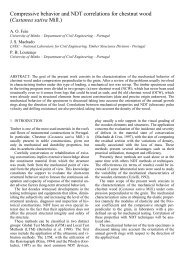
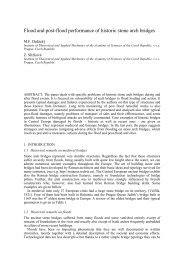
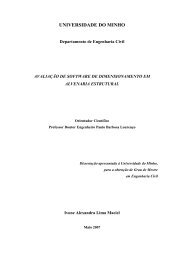
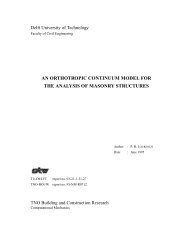

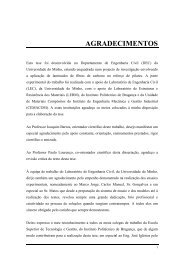

![Weibull [Compatibility Mode]](https://img.yumpu.com/48296360/1/190x134/weibull-compatibility-mode.jpg?quality=85)

